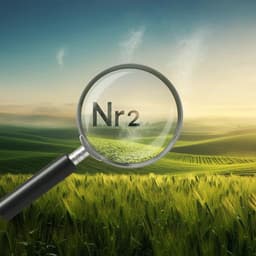
Environmental Studies and Forestry
Societal benefits of halving agricultural ammonia emissions in China far exceed the abatement costs
X. Zhang, B. Gu, et al.
This groundbreaking study on mitigating agricultural ammonia emissions in China reveals the technical potential to cut emissions by 38-67%, offering societal benefits far exceeding the costs. Conducted by esteemed researchers including Xiuming Zhang, Baojing Gu, and Hans van Grinsven, this research highlights strategies for cost-effective mitigation that could alleviate health risks and enhance environmental sustainability.
~3 min • Beginner • English
Introduction
Anthropogenic ammonia (NH3) emissions, mainly from agriculture, drive air pollution, soil acidification, and eutrophication, causing substantial human and ecosystem health damages. While the EU and other regions have implemented NH3 control policies, China—currently the largest NH3 emitter with over 80% from agriculture—lacks targeted NH3 mitigation policies. Low nitrogen use efficiency in crops, poor manure management, and decoupling of crop-livestock systems exacerbate emissions and PM2.5 formation. This study aims to provide an integrated national assessment for China to inform cost-effective strategies by: (1) identifying feasible NH3 abatement options and estimating technical mitigation potential with implementation costs and societal benefits; (2) determining mitigation priorities and strategies via marginal abatement cost curves; and (3) exploring optimal mitigation pathways for 2020–2050 through scenario analysis and cost-benefit assessment. The study addresses whether societal benefits of agricultural NH3 abatement exceed costs and what combinations of measures can deliver large, cost-effective reductions with co-benefits for greenhouse gas mitigation.
Literature Review
Previous work in the EU and North America has quantified NH3 mitigation costs and health damages. The Gothenburg Protocol and subsequent EU directives provided frameworks for ammonia control. Health damage costs linked to agricultural NH3 emissions were estimated at US$55–114 billion for the EU (2008) and US$69–180 billion for the USA (2011), largely due to PM2.5-related mortality. Studies indicate PM2.5 control is more cost-effective when NH3 reductions complement SO2 and NOx controls and that several NH3 abatement measures yield greenhouse gas co-benefits. However, NH3 reductions may increase rain acidity, posing a trade-off. Few countries have quantified national NH3 mitigation potentials, costs, and benefits; this gap is especially large for China, where fertilizer use and livestock numbers have surged, yet mitigation measures validated in the EU/NA have not been widely implemented.
Methodology
The study builds an integrated NH3 mitigation assessment framework combining the CHANS model for agricultural nitrogen budgets and scenario analysis, the GAINS cost methodology for abatement costs and marginal abatement cost curve (MACC) construction, WRF-CMAQ atmospheric modeling for PM2.5 response to NH3 reductions, and exposure–response functions with value of statistical life (VSL) for health benefits. Selection of abatement options: 27 technical measures for crops and livestock were identified based on mitigation efficiency, implementation cost, practical applicability in China, productivity impacts, and greenhouse gas co-benefits. Measures validated in China used domestic parameters; otherwise, costs were derived using China-specific prices and PPP-adjusted transfers. Mitigation potential: NH3 reductions were computed as the product of activity levels, baseline emission factors, abatement efficiencies, and implementation rates across sources and measures (ΔENH3 = Σi Σk Ai × EFi × ηik × Xik). Abatement costs: Annualized costs included investments, fixed (5% of investment) and variable operating costs (additional inputs of feed, energy, labor, water), minus fertilizer savings, using GAINS-consistent formulas and China-specific data (2015 US$ PPP, 2% inflation, technology lifetimes 10–15 years, discount rate per GAINS conventions). Cost-effectiveness and MACC: Measures were ranked by incremental cost-effectiveness to build a bottom-up MACC for agriculture. Scenario analysis (2020–2050): One baseline (BAU) and four mitigation scenarios—DIET (lower share of animal products in diets), NUE (improved nitrogen use efficiency in crops and livestock via management and technologies), REC (enhanced recycling of livestock manure, crop residues, and human waste to cropland), and ALL (combination of DIET, NUE, REC)—were designed with specified 2050 targets for diet share, NUE in cropland and livestock, and recycling ratios. CHANS simulated emissions under each scenario with consistent assumptions for population and GDP and scenario-specific changes to diet structure, NUE, cropping area, and animal numbers. Societal benefits: Total societal benefits equal the sum of human health benefits, ecosystem benefits (avoided acidification and eutrophication damages, scaled from European estimates using PPP and willingness-to-pay adjustments), and greenhouse gas mitigation benefits (avoided abatement costs of CH4 and N2O changes, including 1% indirect N2O from reduced NH3 deposition per IPCC), minus acid rain damages (crop and forest losses estimated from precipitation acidity response and experimental yield responses). WRF-CMAQ provided a nonlinear relationship between NH3 reductions and PM2.5 concentration changes, which, combined with disease-specific exposure–response and Chinese VSL, yielded avoided premature mortalities and monetized health benefits.
Key Findings
- Technical mitigation potential: 38–67% of agricultural NH3 emissions (4.0–7.1 Tg N) can be abated with implementation costs of US$6–11 billion (0.04–0.08% of China’s GDP).
- Sectoral potentials and costs (2020): Cropping systems: 2.0–3.4 Tg N reduction at US$1.9–3.4 billion; Livestock systems: 2.1–3.6 Tg N at US$4.2–7.8 billion. Largest crop potentials: maize 460–954 Gg N, rice 516–684 Gg N, wheat 446–731 Gg N; vegetables 269–493 Gg N (30–55%), fruits 118–235 Gg N (20–40%). Largest livestock potentials: pigs 838–1408 Gg N, poultry 421–843 Gg N, cattle 448–751 Gg N.
- Unit abatement costs: Weighted US$0.8–2.1 per kg NH3-N (lower than EU27’s US$1.2–3.5). Beef cattle have highest unit costs (US$44–86 per LU-year) vs. hogs (US$8–14 per LU-year).
- MACC priorities: About 1.6 Tg NH3-N (≈30% of total reduction) can be achieved at negative cost by reducing excess urea fertilizer and crude-protein feed; together with subsequent low-cost options, ≈3.3 Tg (≈60%) can be abated at zero net cost. Next effective options include covered manure storage (pigs, poultry), improved manure application, housing adaptations for poultry, and improved fertilization management for staple crops. Advanced housing (e.g., air scrubbing) is effective but costly (US$10–30 per kg NH3-N mitigated).
- Air quality and health: A 38–67% NH3 reduction lowers PM2.5 by 8–20%, avoiding 90,000–240,000 premature deaths, with monetized health benefits of US$10–26 billion.
- Ecosystem benefits: Avoided acidification and eutrophication damages amount to US$10–17 billion.
- Climate co-benefits: NH3 mitigation co-reduces agricultural GHGs by 9–35% (101–385 Tg CO2-eq), yielding US$1–3 billion in climate benefits.
- Acid rain trade-off: Reduced NH3 increases precipitation acidity, imposing US$4–7 billion in agricultural and forestry losses.
- Overall societal benefits: Net societal benefits total US$18–42 billion, far exceeding abatement costs.
- 2020–2050 pathways: Under BAU, emissions rise to 12.1 Tg N by 2035 then slightly fall to 11.9 Tg N by 2050 due to livestock demand. DIET (animal product share 40%) reduces NH3 by ~21% by 2050. NUE lowers 2050 emissions to ~8.8 Tg N by cutting synthetic N by ~13 Tg and improving livestock management. REC increases manure recycling, saves 10.9 Tg synthetic N and reduces NH3 by ~24% (3.3 Tg N) in 2050 at ~US$3.8 billion but can raise N2O from soils. ALL achieves ~7.2 Tg NH3-N reduction (≈61% vs BAU) by 2050; about 80% from technical/management measures, ~20% from dietary change; after technical potential is met, diet optimization offers an additional ~12% reduction by 2050.
- Benefits across scenarios (2050): DIET, NUE, and REC each yield human and ecosystem health benefits of ~US$22–26 billion; ALL yields ~US$72 billion. Abatement costs are lowest for DIET (<US$1 billion) and highest for ALL (up to ~US$11 billion).
Discussion
The integrated assessment shows that substantial, cost-effective reductions of agricultural NH3 emissions in China are achievable and yield societal benefits that exceed abatement costs even after accounting for increased acid rain damages. Prioritizing low-cost measures—reducing excessive urea use in croplands and crude-protein content in animal feed—can deliver around 60% of the total technical mitigation at zero net cost, providing a foundation for deeper reductions through manure storage and application improvements, housing adaptations, and optimized fertilization practices. Scenario analysis indicates multiple viable pathways: dietary shifts, improvements in nitrogen use efficiency, and enhanced nutrient recycling each contribute meaningfully; their combination achieves the largest reductions with maximal health and ecosystem benefits. International comparison underscores China’s higher relative mitigation potential (about twice the EU27) and lower unit costs due to current practice gaps and labor cost structures, although further reductions become progressively more expensive. The results support coordinated control of NH3 alongside SO2 and NOx to address PM2.5 pollution comprehensively, and highlight synergies with greenhouse gas mitigation, while acknowledging trade-offs with acid deposition that require parallel strategies to protect crops and forests.
Conclusion
China can halve agricultural ammonia emissions with available measures at costs far below the resulting societal benefits. A strategic, staged approach that first captures negative- and zero-cost abatement—curbing excess urea use and protein-rich feeding—followed by manure management upgrades, housing adaptations, and improved fertilization can deliver 38–67% NH3 reductions nationally. By 2050, combining technical measures with dietary optimization can achieve about a 61% reduction relative to BAU, with major improvements in air quality and public health, significant ecosystem benefits, and greenhouse gas co-benefits. Policy actions should integrate NH3 control into national air quality and climate strategies, provide technical support and incentives (e.g., for enhanced-efficiency fertilizers, mechanization, manure recycling), and facilitate structural reforms (e.g., farm scaling and reconnecting crop–livestock systems). Future research should refine regionalized assessments, quantify yield and productivity effects of measures, incorporate broader climate–aerosol interactions, and evaluate policy mixes that jointly optimize NH3, SO2, and NOx controls while safeguarding against acid rain impacts.
Limitations
The assessment does not quantify impacts of NH3 mitigation on crop yields and animal productivity due to limited China-specific data, potentially underestimating cost-effectiveness. Regional heterogeneity in agricultural systems and environmental conditions is not explicitly modeled, which may affect national estimates and local applicability. Climate benefits are limited to non-CO2 GHGs (CH4 and N2O), excluding CO2-related supply chain emissions and broader aerosol–climate–carbon cycle interactions. Complex atmospheric chemistry among SO2, NOx, and NH3 introduces uncertainty, and future SO2/NOx controls may partially offset NH3 mitigation effects. Projections to 2050 assume current technologies and may not capture future technological advances or policy innovations. Public costs (e.g., subsidies) are not included in abatement cost estimates, and acid rain damage estimates carry uncertainty from precipitation acidity modeling and impact functions.
Related Publications
Explore these studies to deepen your understanding of the subject.







